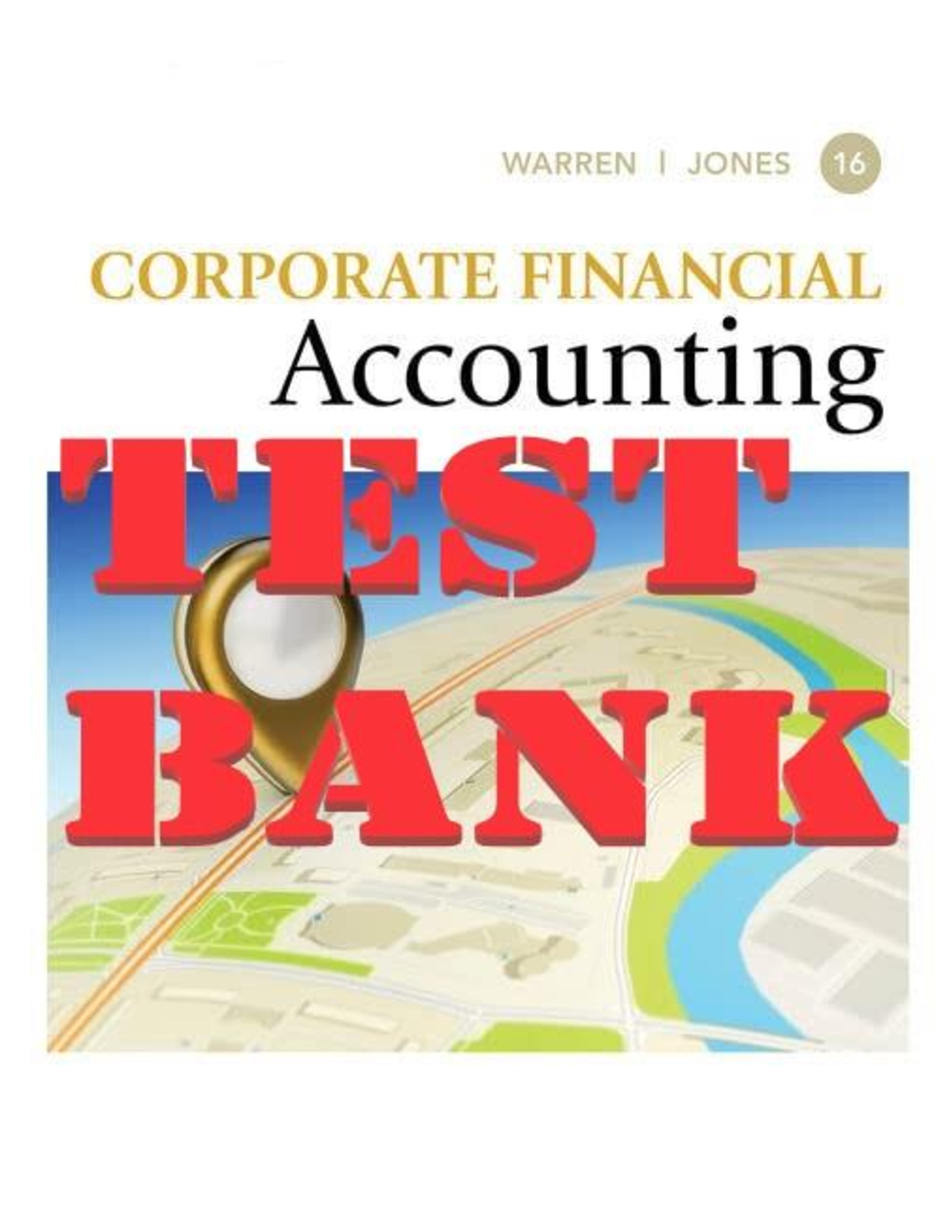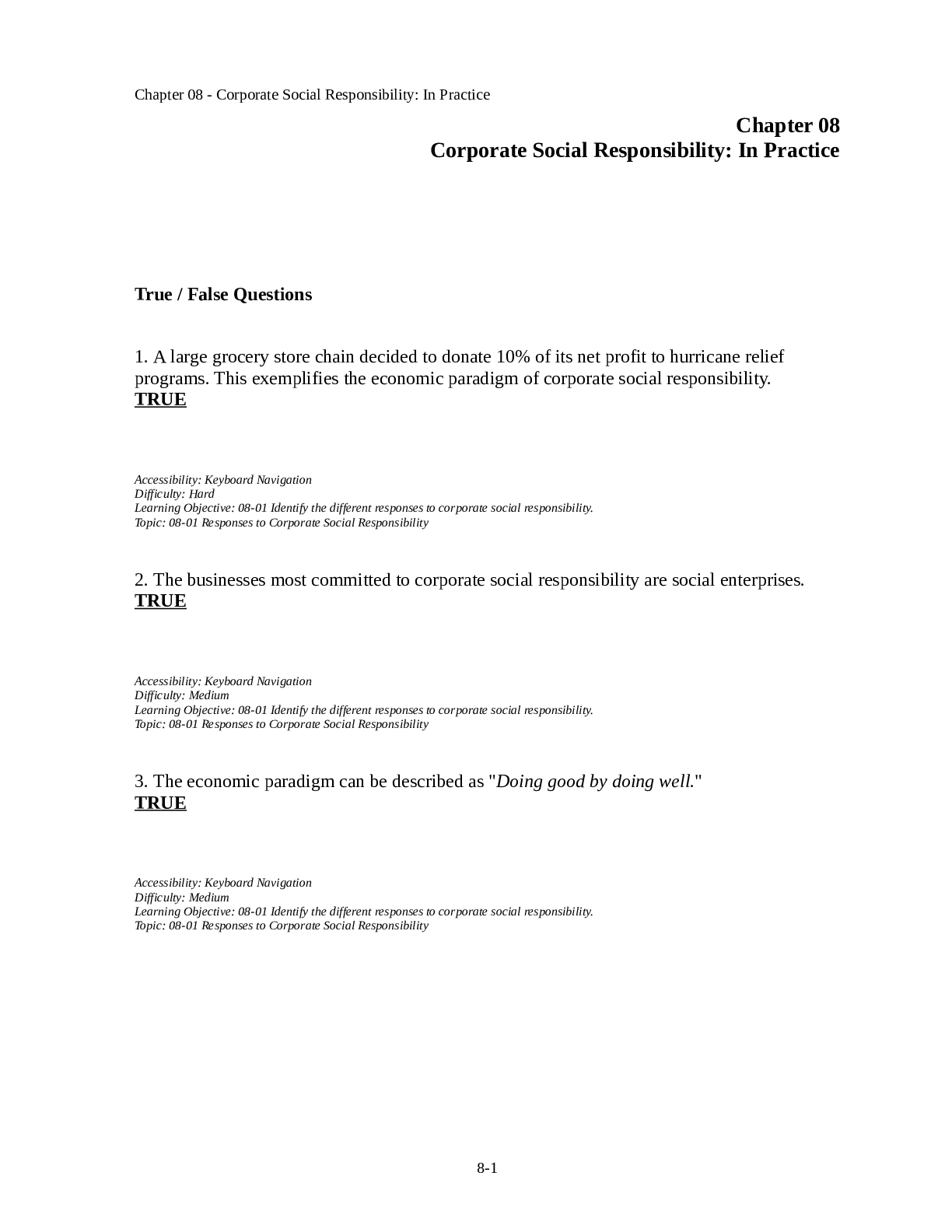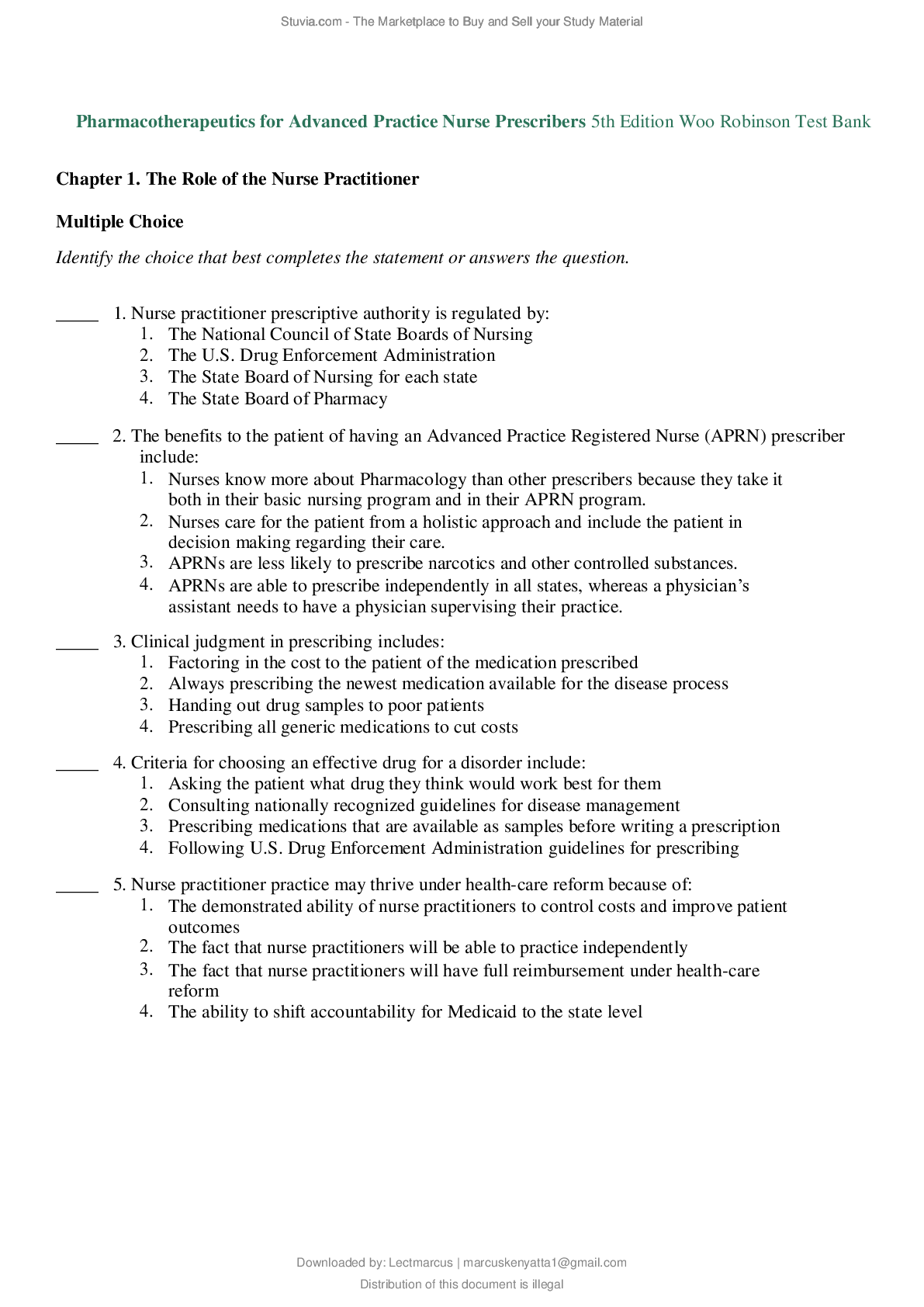Project Management > TEST BANKS > Estimating Project Times and Costs . Chapter 05 Answer Key. 91 Questions and Answers (All)
Estimating Project Times and Costs . Chapter 05 Answer Key. 91 Questions and Answers
Document Content and Description Below
Chapter 05 Estimating Project Times and Costs Answer Key Multiple Choice Questions 1. The process of forecasting or approximating the time and cost of completing project deliverables is c... alled A. Budgeting B. Predicting C. Estimating D. Planning E. Guesstimating 2. In practice, estimating processes are frequently classified as A. Top down/bottom up B. Rough/polished C. Precise/order of magnitude D. Draft/final E. Broad/Specific 3. What is the relationship between organizational culture and estimating? A. There is no relationship B. Cultural norms affect the accuracy of estimates C. Culture determines whether estimates are made D. Estimating alters cultural norms E. Estimating and culture are independent 4. A good starting point for developing time and cost estimates is A. Past experience B. Work packages C. Task analysis D. Time and motion studies E. Work breakdown structure 5. Which of the following is NOT one of the factors that need to be considered to improve quality of estimates for project times and costs? A. Planning horizon B. People C. Padding estimates D. Profit E. Project structure 6. Ed is looking over the actual results of projects and comparing them to what was estimated. He notices that the projects that took six months or longer to complete were noticeably more off the estimates. Which of the following factors is he recognizing? A. Padding estimates B. Project duration C. Project structure D. People E. Organization culture 7. Janet is forecasting how much money her department needs to support a new project. She estimates that two people and $25,000 in expenses will cover her needs. Because management typically insists on reducing forecasts by 20 percent, she increases her estimates to allow for that reduction. Which of the following factors is illustrated in this situation? A. Padding estimates B. Planning horizon C. Project structure D. People E. Organization culture 8. Which of the following is a good condition for top-down estimating? A. Cost and time important B. Fixed price contract C. Customer wants details D. Internal, small project E. Large scale project involving several subcontractors 9. Which of the following is a good condition for bottom-up estimating? A. When the project involves strategic decision making B. When the project is internal and small C. When there is a fixed price contract D. When there is high uncertainty involved in the project E. When there is an unstable scope 10. Richard is collecting estimates for a house that he will have the funding to build in 12 months. Which of the following factors does Richard need to consider in regard to the quality of these estimates? A. Padding estimates B. Planning horizon C. Project structure D. People E. Project duration 11. Which of the following does NOT help describe a bottom-up estimating approach? A. Made by someone who uses experience and/or information from someone else to determine overall project cost and duration B. Establishes low-cost, efficient methods for completing activities C. Typically comes from the people actually doing the work and who are most knowledgeable about the task at hand D. Estimates are made at the work package level and then “rolled up” to determine estimates for major deliverables and for the project itself E. Can take place after the project has been planned in detail 12. Which of the following methods is NOT considered a top-down approach to estimating project time and cost? A. Ratio B. Template C. Apportion D. Function point E. Learning curve 13. Jose is forecasting project time and cost for constructing a new building by multiplying the total square footage by a given dollar amount. Which of the following methods is he using? A. Ratio B. Template C. Apportion D. Function point E. Learning curve 14. Sean is forecasting the time and cost of developing a customized software program by looking at the number of inputs, outputs, inquiries, files, and interfaces. Which of the following methods is he using? A. Ratio B. Template C. Apportion D. Function point E. Learning curve 15. Laura is forecasting the time and cost of developing an intranet for a new customer. Her department has completed six such intranets for customers during the last two years. Although the proposed system is about the same size as the others, she estimates that it will take about 10 percent less time and money. Which of the following methods is she using? A. Ratio B. Template C. Apportion D. Function point E. Learning curve 16. Learning curves are more likely to be applied in situations where most of the costs are A. Materials B. Labor C. Overhead D. Evenly spread over materials, labor, and overhead E. Labor and materials 17. Which of the following describes the consensus method? A. Should be used only for projects that require the same task, group of tasks, or product to be repeated several times B. Uses several people with relevant experience regarding the task at hand to make time and cost estimates C. Uses pooled experience of senior and/or middle managers to estimate the total project duration and cost D. Uses the number of square feet to estimate the total cost and time of the project E. Uses weighted macro variables or major parameters such as the number of inputs or outputs to estimate the total cost and time of the project 18. Which of the following is NOT one of the bottom-up approaches to estimating project time and cost? A. Parametric procedures applied to specific tasks B. Estimates for the WBS work packages C. Learning curve D. Template method E. Range estimates 19. Which of the following would be the best method for projects where the final product is not known and the uncertainty is very large? A. Function point B. Template C. Learning curve D. Phase estimating E. Apportion 20. Rob is responsible for estimating a work package that has a significant amount of uncertainty associated with the time and cost to complete. Due to the uncertainty involved he will be making a low, an average and a high estimate. Rob is using which estimating approach? A. Parametric procedures applied to specific tasks B. Template method C. Apportion method D. Range estimating E. Learning curve 21. Which of the following is NOT true in regard to the level of detail estimates should contain? A. It will vary with the complexity of the project B. Detailed estimates are crucial to project success, therefore an effort should be made to make estimates as detailed as possible for all projects C. The more detailed the estimate is the more the estimate will cost to create D. Inadequate detail might lead to estimates that fall short of their intended purpose E. Excessive detail means unproductive paperwork and unnecessary expenditures 22. The salary of the project manager would be an example of what type of cost found in a project? A. Labor B. Direct C. Direct project overhead D. General and administrative overhead E. Salary 23. Typical kinds of costs found in a project include all of the following EXCEPT A. Direct costs B. Project overhead costs C. General and administrative overhead costs D. Labor E. All of these are examples of costs found in a project 24. Accounting would be an example of which of the following costs typically found in a project? A. Labor B. Direct C. Direct project overhead D. General and administrative overhead E. Salary 25. Which of the following would best represent direct project costs? A. Only labor B. Only materials C. Only equipment D. Both labor and materials E. Labor, materials and equipment 26. Which of the following is NOT one of the recommended guidelines for developing useful work package estimates? A. Estimates should be made by those responsible for the work B. Use several people to estimate the same work C. Estimates should be based on normal conditions D. Estimates should include a normal level of contingency E. Estimates should be independent of other projects 27. Companies are using which of the following for improving the estimating process for future projects? A. Adjusting estimates based on individual forecasting abilities B. Benchmarking and using the experience of other companies C. Using time and motion studies D. Creating historical databases of previous projects E. Establishing an estimating training course for all employees 28. Reasons why estimating time and cost are important include all of the following EXCEPT A. To schedule work B. To determine how long the project should take and cost C. To develop cash flow needs D. To determine how well the project is progressing E. To help establish a project selection process 29. The bottom-up approach for estimating times and costs that uses costs from past projects that were similar to the current project is known as A. Detailed WBS work package estimates B. Template method C. Function point method D. Time-phased cost estimates E. Phase estimating 30. Which of the following top-down methods is used when projects closely follow past projects in regard to features and costs of those features, and result in costs being assigned by percentages to major segments of the project? A. Apportion B. Function point C. Phase estimating D. Learning curve E. Consensus 31. Refining estimates may be necessary for a number of reasons. For example, resource shortages, in the form of people, equipment, or materials, can extend original estimates. This is a good example of A. Hidden interaction costs B. Things going wrong on a project C. Normal conditions not applying D. Changes in project scope E. The customer not being clear about their expectations 32. Refining estimates may be necessary for a number of reasons. For example, people working on prototype development needing time to interact with the design engineers after the design is completed is a good example of A. Hidden interaction costs B. Things going wrong on a project C. Normal conditions not applying D. Changes in project scope E. The customer not being clear about their expectations 33. Refining estimates may be necessary for a number of reasons. For example, a manager getting further into a project and obtaining a better understanding of what needs to be done to accomplish a project and meet the needs of the customer is an example of A. Hidden interaction costs B. Things going wrong on a project C. Normal conditions not applying D. Changes in project scope E. There is never a good reason to refine estimates 34. Refining estimates may be necessary for a number of reasons. For example, design flaws being revealed after the fact, extreme weather conditions, and accidents occurring are good examples of A. Hidden interaction costs B. Things going wrong on a project C. Normal conditions not applying D. Changes in project scope E. None of these are correct Fill in the Blank Questions 35. When work package estimates are made by individuals most knowledgeable about the work being performed and these estimates are then “rolled up” to find estimated costs for major deliverables and the project itself, ____________ estimating is being used. 36. When someone uses experience and/or information from others to determine the project duration and total cost, ____________ estimating is being used. 37. The estimating factor that considers the decreasing accuracy of estimates as one forecasts activities that are further into the future is known as ____________. 38. The estimating factor that considers the skill level of participants doing the estimating is known as the ___________ factor. 39. The estimating factor that considers the tendency to overestimate project time and cost in order to improve the likelihood of meeting the estimates is known as the ___________ factor. 40. The estimating factor that considers the prevailing belief in some firms that detailed estimating takes too much time and is not worth the effort is an example of the ___________ factor. 41. The preferred method for situations involving strategic decision making, projects with a high degree of uncertainty, and projects with an unstable scope is the ___________ approach to estimating project time and costs. 42. The preferred method for situations where the cost and time estimates are important, in a fixed contract situation, and when the customer wants a lot of detail is the ___________ approach to estimating project time and costs. 43. The information necessary to conduct a bottom-up estimate of project time and costs starts with the ___________. 44. Jose is forecasting project time and cost for constructing a new building by multiplying the total square footage by a given dollar amount. He is using the ___________ method of top-down estimating. 45. Rose is working on estimates for a project that is very similar to a previous project, in that it has many of the same features and those features have similar costs. Each feature or deliverable will represent the same percentage of the total cost as it did for the previous project. Rose is using the _________ method of top-down estimating. 46. The top-down method for estimating project time and cost that uses weighted variables based on major parameters and is frequently used in the development of software is known as the ____________ method. 47. The top-down method of estimating project time and costs that is useful for projects requiring the same task, group of tasks, or product repeated several times, especially if it is labor intensive, is the ______________. 48. The bottom-up method of estimating where work package time and costs for past projects are used as a starting point for a new project and adjustments are made based on differences in the new project is known as the ___________ method. 49. The top-down method of estimating when the pooled experience of senior and/or middle managers are used to estimate the total project duration and cost is the _________ method. 50. The approach to estimating project time and cost that begins with an overall estimate for the project and then refines estimates for various stages of the project as it is implemented is known as ____________. 51. The estimating approach that is best to use on projects where there is an unusual amount of uncertainty surrounding the project and when it is impractical to estimate times and costs for the entire project is known as ___________. 52. A way to improve estimates on future projects is to collect and archive data on past project estimates and actuals. Creating a ___________ for estimating is a way to achieve this goal. 53. Project costs such as labor and materials are typically classified as ___________ costs. 54. The salary of the project manager and temporary rental space for the project team would be classified as __________ costs. 55. Estimates should be made based on ___________ conditions, efficient methods, and a normal level of resources. 56. Costs that are associated with time devoted to the coordination in meetings and briefings as well as time necessary to resolve disconnects between tasks are known as ____________ costs. 57. Costs that are not directly related to a specific project, such as advertising, accounting, and senior management salary, are classified as _____________ costs. True / False Questions 58. Project estimates should be broken down into as much detail, and with as much accuracy, as possible. 59. Cost, time, and budget estimates are the lifeline for control; they serve as the standard for comparison of the actual and the planned throughout the life of the project. 60. Past experience is almost always used primarily in the initial phases of estimating. 61. After averaging out the underestimates and overestimates, a long-duration project is more likely to be on target than a short-term, small project. 62. The process of forecasting or approximating the time and cost of completing project deliverables is called planning. 63. The project management structure chosen to manage the project will have little impact on the quality of estimates. 64. As long as everyone in a project adds a little padding to reduce risk, the project duration and cost estimates will be more accurate. 65. Organization culture can significantly influence project time and cost estimates. 66. If a project is internal to the company and relatively small, the bottom-up approach to estimating time and costs for the project is the best choice. 67. If time and costs are important to a project the top-down approach to estimating time and costs for the project is the best choice. 68. The ideal approach to estimating project time and costs is to use both the top-down and the bottom-up approach. TRUE Feedback: The ideal approach is for the project manager to allow enough time for both the 69. Estimates that are typically based on estimates of elements found in the work breakdown structure are called bottom-up estimates. 70. Top-down estimates usually are derived from someone who uses experience and/or information to determine the project duration and total cost. 71. Estimating the total cost of a house by multiplying the total square feet by cost per square foot is an example of the apportion method of estimating costs. 72. Estimating the total cost of a project by multiplying each major function by a complexity factor is an example of the apportion method of estimating costs. 73. Phase estimating is used when a project cannot be rigorously defined because of the uncertainty of design or the final product. 74. All task time estimates need consistent time units. 75. One guideline to follow when estimating time, cost and resources is to use several people to make the estimate for a task. 76. The consensus method of estimating costs is a bottom-up technique. 77. The salary of the project manager and her administrative assistant is classified as direct labor costs. 78. General and administrative costs are usually allocated as a percent of the total of a direct cost which includes labor, materials, or equipment. 79. Work package estimates should include allowances for contingencies. 80. Estimates are supposed to be based on normal conditions. While this is a good starting point, it rarely holds true in real life. Short Answer Questions 81. Identify and briefly describe the two major classifications of estimating project time and costs. 82. List and briefly describe four reasons why estimating time and cost is important to project management. 83. Identify and briefly describe three out of the six factors that should be considered to improve the quality of estimates for project times and costs. 84. Under what conditions would the top-down approach to estimating project times and costs be the best choice? 85. Under what conditions would the bottom-up approach to estimating project times and costs be the best choice? 86. Describe the ideal approach for a project manager to develop optimal estimates for a project's time and costs. 87. Estimates should be based on normal conditions, efficient methods, and a normal level of resources. Explain. 88. Describe phase estimating. When should it be used and how is it different from all other top-down and bottom-up methods of estimating? 89. Identify the drawbacks to an excessive level of detail in project times and costs. 90. Identify the three major categories of project costs and give an example of each. 91. List and describe two reasons why estimates may need to be refined. [Show More]
Last updated: 2 years ago
Preview 1 out of 37 pages

Buy this document to get the full access instantly
Instant Download Access after purchase
Buy NowInstant download
We Accept:

Reviews( 0 )
$6.00
Can't find what you want? Try our AI powered Search
Document information
Connected school, study & course
About the document
Uploaded On
Jan 18, 2021
Number of pages
37
Written in
Additional information
This document has been written for:
Uploaded
Jan 18, 2021
Downloads
0
Views
294
.png)























